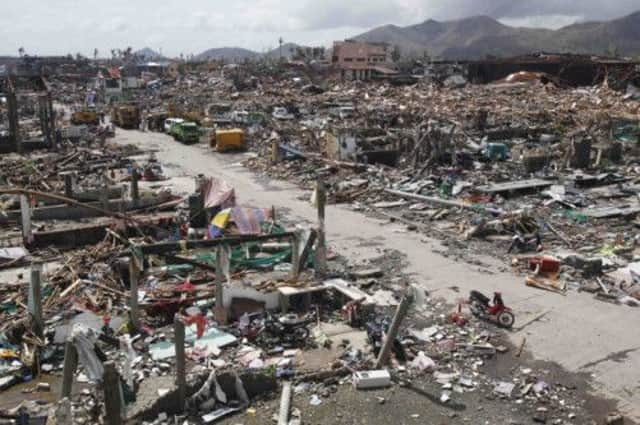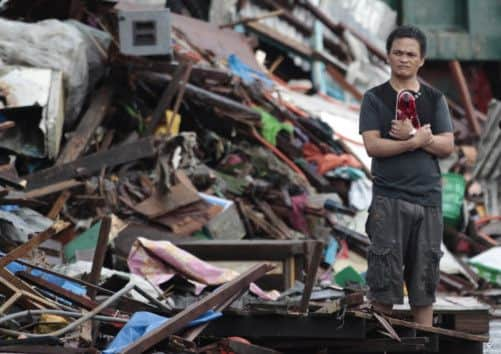Typhoon Haiyan: Survivors confront devastation


The monumental force of Super Typhoon Haiyan left corpses hanging from trees and trapped under flattened buildings, while looters raided grocery shops and petrol stations.
Men, women and children were forced to tread carefully over splintered wrecks of wooden houses, searching for loved ones. From the air, TV footage showed trees pulled up by their roots and ships washed ashore.
Advertisement
Hide AdAdvertisement
Hide AdThose who survived the devastation in Tacloban City waited in queues for handouts of rice and water, many covering their faces with rags to keep out the smell of the dead.


One woman, eight months pregnant, said 11 members of her family, including two daughters, had vanished in the storm. “I can’t think right now,” she said. “I am overwhelmed.”
Some survivors trekked for hours to Tacloban’s airport, hoping to be evacuated by military aircraft. Roads to and from the city remained impassable, littered with debris and fallen trees. Only 110 people can squeeze on to each flight, with the elderly, sick and children given priority.
“We are trying to get to Cebu or Manila,” one distraught tourist said. “I must get out.”
Jenny Chu, a medical student, said she could not recognise her village. “Everything is gone,” she said. “We are running out of food and water. We are looking for food everywhere.
“Even the delivery vans were looted. People are walking like zombies looking for food.”
Not one building seems to have escaped damage in Tacloban, a city of 220,000 people, the capital of Leyte province, about 360 miles from Manila.
The UN’s Office for the Co-ordination of Humanitarian Affairs said aerial surveys showed “significant damage”, with heavy ships thrown ashore, houses flattened and vast tracts of agricultural land destroyed.
Advertisement
Hide AdAdvertisement
Hide AdNancy Chang, who was on a business trip to Tacloban from China, walked for three hours through mud and debris to join the military-led air evacuation.
“Seawater reached the second floor of the hotel,” she said. “It’s like the end of the world.”
One Tacloban resident said he and others took refuge inside a parked Jeep, but it was swept away by a surging wall of water.
“The water was as high as a coconut tree,” said Sandy Torotoro, 44, a bicycle taxi driver who lives near the airport with his wife and eight-year-old daughter.
“I got out of the Jeep and I was swept away with logs, trees and our house, which was ripped off from its mooring.”
Lieutenant Colonel Fermin Carangan, of the Philippines air force, recalled how he and 41 officers huddled in their airport office as winds reached terrifying speeds of up to 235mph.
“Suddenly, the waves destroyed the walls, and I saw my men being swept by waters one by one. Two drowned and five are missing,” he said.
Lt Col Carangan clung to a coconut tree with a seven-year-old boy. “In the next five hours we were in the sea buffeted by wind and strong rain,” he said.
Advertisement
Hide AdAdvertisement
Hide AdHe finally saw land and swam with the boy to a beach strewn with dead bodies.
“I think the boy saved my life, because I found strength so that he could survive,” he added.
The country’s interior secretary, Manuel Roxas, who has been in Tacloban since before the typhoon struck, said: “It was like a tsunami. Up to a kilometre inland, there are no structures standing.
“I don’t know how to describe what I saw. It’s horrific.”
Witnesses said looters rampaged through Tacloban, taking whatever they could find as rescuers struggled to deliver food and water.
Mobs attacked lorries loaded with food, tents and water, said Philippines Red Cross chairman Richard Gordon.
President Benigno Aquino said the government had deployed 300 soldiers and police to restore order, and he was considering introducing martial law in Tacloban to stop the looting.
Past horrors
Deadliest storms to hit the Philippines:
Tropical storm Thelma 2-7 November, 1991 5,101 deaths
Typhoon Bopha 3 December, 2012 1,900 deaths
Typhoon Ike 31 August to 4 September, 1984 1,492 deaths
Typhoon Agnes 3 to 6 November, 1984 1,167 deaths
Tropical storm Washi 16 December, 2011 1,080 deaths
Typhoon Trix 17 to 22 October, 1952 995 deaths
Typhoon Amy 9 December, 1951 991 deaths
Typhoon Nina 23 to 27 November, 1987 979 deaths
Typhoon Fengshen 18 to 23 June, 2008 938 deaths
Typhoon Angela 30 October to 4 November, 1995 882 deaths